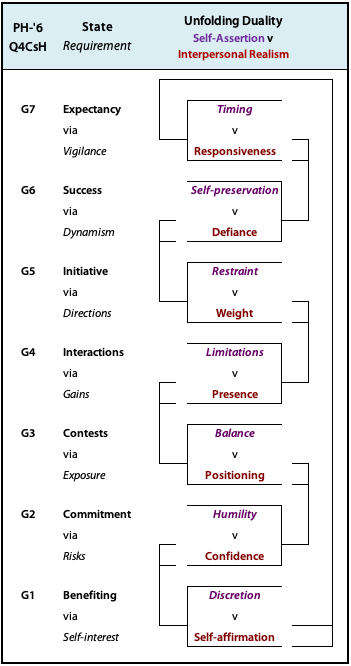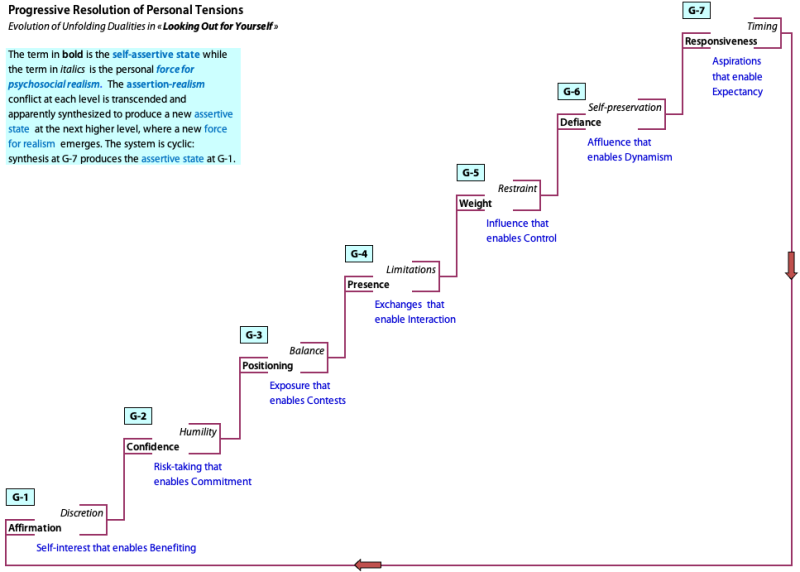Self-assertion & Psychosocial Realism
Unfolding Duality Principles
Unfolding dualities are found in principal typologies and structural hierarchies. Some are rather easy to determine and contain perennial dichotomies: mental stabilization (PH'4uD), for example, with its body-mind polarity; and political life (PH'6CsHuD) with principles v pragmatism at the base.
Generally speaking, the unfolding duality is characterized by a sustaining ground state that is essential and unavoidable, and an opposing force that harbours potential for development. These are respectively the thesis and antithesis, which can fuse to generate a synthesis at the next higher level. That synthesis is then a new thesis evoking its antithesis and so on with the system being cyclic so that the synthesis at G7 appears as the thesis at G1.
Application to Looking out for Yourself
For , the generic ground state (the thesis) is taken to be self-assertion because without asserting your self it is not possible to look out for yourself.
However, self-assertion is intrinsically socially destabilizing. Others will not allow destabilization, and you will certainly not tolerate excessive self-assertion by others. So there is an opposing force within each person (the antithesis) that can be generically labeled psychosocial realism.
G1: Benefiting that requires Self-interest

The ground state for self-assertion at is affirmation. On an episodic basis, it is necessary and perfectly acceptable to affirm what you think, what you intend, what you want or need, or who you can do.
But this occurs in a competitive environment and, if taken too far or too persistently, others will react and object. At the extreme, they will combine to negate and undermine your efforts now and possibly in the future. To avoid this blow-back, you need to be realistic and exert discretion in dealings where self-affirmation seems beneficial and even appropriate.
G2: Commitment that requires Risk-taking
The tension between self-affirmation and discretion at is resolved by confidence, a new ground state for which emerges through a natural fusion of these two poles. A confident person unhesitatingly asserts themselves in an appropriate discrete way at all times. Confidence needs to be routine but it can get out of hand leading to over-confidence, arrogance and excessive or inappropriate risk-taking.
So confidence needs to be balanced by a realism that is experienced psychologically as humility. With humility, risks can be confidently taken with a degree of safety and assurance that you judge them to be reasonable and manageable.
G3: Contests that require Exposure
Combining confidence and a humility in allows for positioning which becomes the new ground state. Exposure of yourself reveals your position and involves sporadic self-assertion which, even if it carries its own risks, is unavoidable.
Exposure is naturally episodic and needs to be titrated: not too much or you make yourself a target and not too little or no-one knows where you stand and you become isolated. Positioning can be realistically allowed if a need for balance is operating as a countervailing force.
G4: Interactions that require Exchanges
The tension between positioning and balance at can be resolved by fusion into a recognizable presence, which is the ground of self-assertion.
Gains come from exchanges with others and it is impossible to interact for benefit and make the arrangement or get the gain you are seeking without asserting your presence on a routine basis. However, forcing yourself on others, particularly if you lack what they want will get you ignored or excluded. Psychosocial realism demands that you are aware of your own limitations when you deal with others.
G5: Control that requires Influence
Synthesis of your presence and limitations at emerges at in the form of the psychosocial weight that you possess. People vary greatly. However whether you are perceived as a light-weight or a heavy-weight, it is essential that you assert that weight from time to time.
It is important however not to throw your weight around routinely or you will be avoided, excluded or even ejected from the field. Psychosocial realism demands that you restrain yourself, even if that means not being controlling when you believe that might be to your benefit and might even help others too.
G6: Affluence that requires Dynamism
The tension between your weight and restraint at is resolved by synthesis as a state of defiance. This ground state emerges when you must confront situations that threaten your standard of living. Defiance mobilizes your personal energies on a continuous basis, allowing you to deal with the harsh reality that the world is not organized for your benefit.
However, another harsh reality is that the world is far more powerful than you are, which means that you can be easily crushed if you take defiance too far. Realism demands that you master yourself with countervailing urges for self-preservation.
G7: Aspirations that require Expectancy
Defiance and self-preservation are fused in a sensitivity to what is going on about you that is expressed as responsiveness. Aspirations support your expectation that you will be sporadically faced with opportunities to pursue your dearest ambitions.
However, it is necessary to be careful as to when you respond and when you simply note what is occurring but let matters pass. In the psychosocial realm, timing is everything.
The fusion of responsivenss and timing emerges as [self-]affirmation, the form of self-assertion at , and that confirms cyclicity.
![]() See another diagram of the same duality progression.
See another diagram of the same duality progression.
- Preview the structure in terms of the function, requirement and state of each of the groupings.
- This account included a time oscillation: see more oscillations.
-
Start with serving self-interest-G1 Monads.
Originally posted: 10-July-2025.
